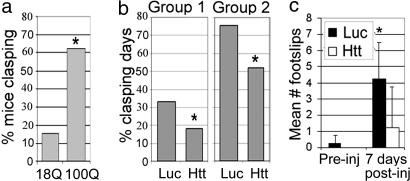Fig. 5.
AAVHtt100Q mice show reduced motor deficits in the presence of cc-siRNA-Htt. (a) Percent of mice clasping 14 days after injection with AAVHtt18Q and AAVHtt100Q. Mice with AAVHtt100Q had significantly more clasping days than mice infected with AAVHtt18Q. AAVHtt18Q, 15% clasping, n = 13; AAVHtt100Q, 62.5% clasping, n = 16 (P = 0.02). (b) AAVHtt100Q mice cotreated with cc-siRNA-Htt had fewer clasping days than mice coinjected with cc-siRNA-Luc (group 1: cc-siRNA-Luc, 33%, n = 9, versus cc-siRNA-Htt, 18%, n = 8; *, P = 0.01; group 2: cc-siRNA-Luc, 75%, n = 5, versus cc-siRNA-Htt, 52%, n = 6; *, P ≤ 0.02; Fisher's exact test). (c) Shown are mean ± SD footslips that occurred during beam walking for mice injected with AAVHtt100Q. Mean footslips were reduced in the presence of cc-siRNA-Htt compared with cc-siRNA-Luc. *, P ≤ 0.01; Student's t test; n = 4 per group.

